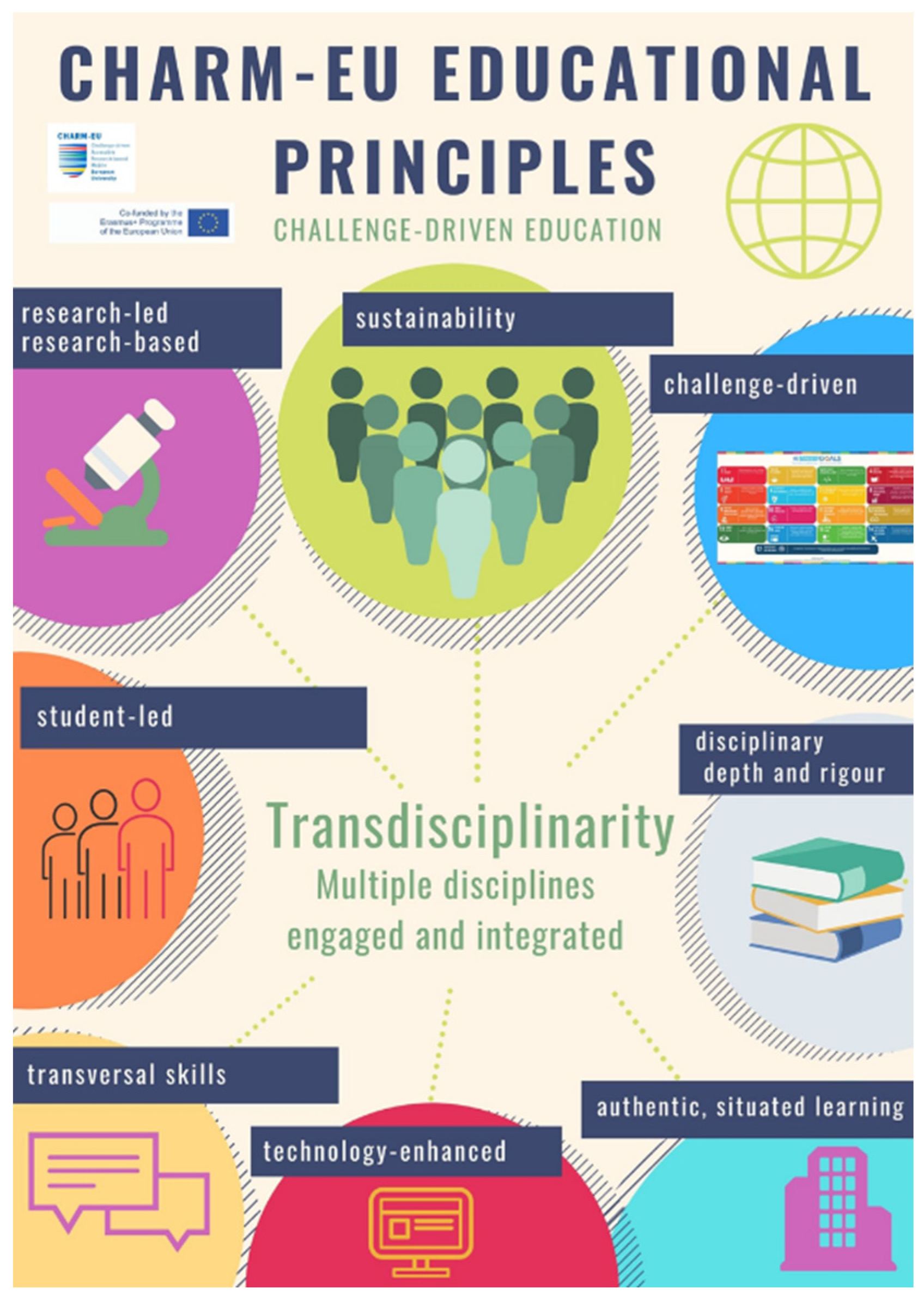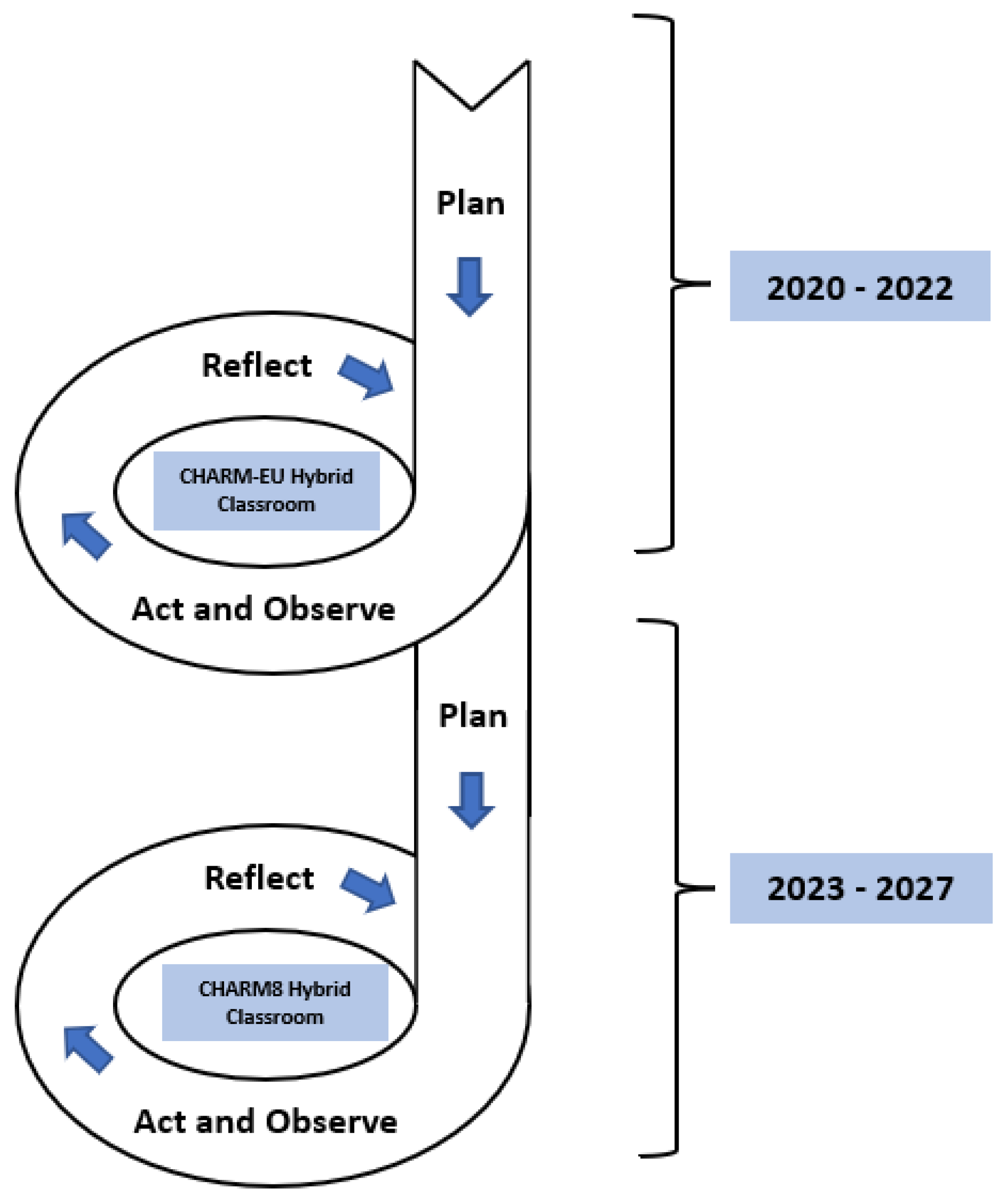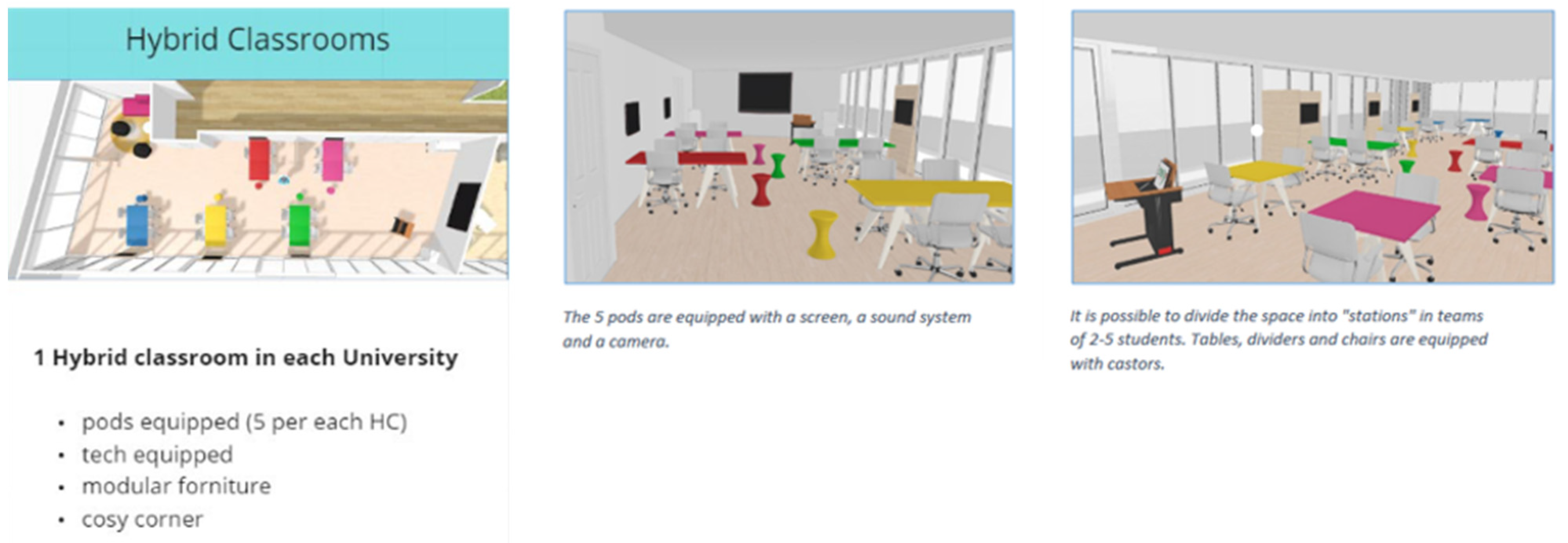Best Practices for Sustainable Inter-Institutional Hybrid Learning at CHARM European University
Abstract
1. Introduction
1.1. CHARM European University
1.2. Hybrid Learning via a Hybrid Classroom in an HEI Co-Operation
2. Methodology: Participatory Action Research
Positionality and Methods Used
3. Results: PAR Cycle
3.1. Plan (Design of the Hybrid Classroom)
3.1.1. Educational Principles Integration
3.1.2. Physical Build
3.1.3. Software Tools
3.1.4. Pedagogical Needs Analysis of Transdisciplinary Teams
3.2. Act (Implementation of the Hybrid Classroom)
3.2.1. Staff Roles and Training Materials
3.2.2. Alignment with Module Learning Outcomes
3.2.3. Testing
3.3. Observe (Delivery of the Hybrid Classroom for CHARM-EU MSc)
Use Cases
3.4. Reflect
3.4.1. What Went Well
Planning
Delivery
3.4.2. What Could Be Improved
3.4.3. Implication for Future Plans/Cycles
Planning
Delivery
4. Discussion: Lessons Learned and Recommendations for Future Practice
- Explore the pedagogical, structural, financial, and organizational needs of the educational award being delivered in the hybrid classroom from the perspective of all stakeholders (e.g., curriculum and instructional designers, hardware and software specialists, institutional IT departments support, VLE experts, teaching, administration, quality, policy, and finance staff).
- Collaboratively produce a layout guide with key requirements with individuals from each hybrid classroom. Although the hybrid classroom space may differ in each location, discussing what elements are essential and viable across each location is crucial.
- Inclusivity experts should be consulted during the design phase to ensure Universal Design for Learning (UDL) principles are integrated.
- Accept that differences in quality will arise across hybrid classroom spaces due to localized factors (e.g., audio, bandwidth, environmental factors). Aim to mitigate these issues through support and collaboration across institutions.
- Classroom furniture should be easily reconfigured to allow for different types of classroom activities.
- Create user profiles for each person working in the hybrid classroom (e.g., teachers, Teaching Assistants, VLE support, guest speakers, and students). This supports both pedagogical and organizational design.
- Consider the teaching modalities that will be used in your hybrid classroom and adjust design requirements accordingly. For example, will all teachers be on site or accessing remotely? Will students be working in groups, individually, or accessing the classroom online?
- Engage with Module Coordinators and teachers to plan for teaching activities in the hybrid classroom. Identify what requirements they need to align with their activities.
- Ensure adequate time and planning for testing across and within each hybrid classroom.
- Invest in high-quality audio equipment, including microphones and speakers. Audio hardware that includes a built-in noise-cancellation feature is recommended.
- Aim to have the same or similar hardware across all hybrid classrooms to ensure consistency of learning. This can be challenging due to preferred suppliers and tendering across universities. A minimum viable product should be agreed upon across all universities.
- Make the hybrid classroom an inviting space for students. Consider comfortable furniture, plants, and posters.
- Ensure that all teaching staff prepares and adheres to a well-prepared lesson plan. Sessions should be broken down into small sections, with clear instructions both spoken and documented on screen.
- Ensure that the teaching staff are trained in the hardware and software used in the hybrid classroom. Both static documentation and practical hands-on training sessions before the teacher delivers their content are recommended. Provide support or professional development for teachers to align their design with the educational or pedagogical philosophy and hybrid learning principles.
- Implementation:
- Technical and teaching support staff are crucial to smooth implementation. Ensure that each hybrid classroom always has on-site support staff during teaching activities.
- Be transparent with students if technical problems arise. Explain the issue and provide a short, localized task for students while the problem is being rectified.
- Communicate with students about the location of the session and where to access files before the session. If they experience technical issues, they are aware of where they need to reconnect to.
- Teachers should avoid jumping to and from multiple applications without a clear explanation in a session.
- Teachers should prepare local fall-back activities in case of technical failures across hybrid classrooms.
- Teachers should minimize movement when in the classroom to avoid issues with lighting, bandwidth, and sound.
- Consider inclusivity in the hybrid classroom.
- Communicate to students and teaching staff about what hardware they need for the hybrid classroom (i.e., headphones, laptop). Aim to support students in need if they lack these resources.
- The time required to address technical support issues exceeded our expectations considerably in the first weeks of the programme. Capacity planning should be prioritized to reduce staff stress and foster technical knowledge across a wider range of staff members.
Future Research
5. Conclusions
Author Contributions
Funding
Institutional Review Board Statement
Informed Consent Statement
Data Availability Statement
Acknowledgments
Conflicts of Interest
References
- Karvounaraki, A.; Subramaniam, S.; Hristov, H.; Ojala, T.; Jonkers, K.; Huisman, J.; Goenaga, X. Mapping of European Transnational Collaborative Partnerships in Higher Education; Publications Office of the European Union: Luxembourg, 2018. [Google Scholar]
- Cooper, J.; Mitsunaga, R. Faculty perspectives on international education: The nested realities of faculty collaborations. New Dir. High. Educ. 2010, 2010, 69–81. [Google Scholar] [CrossRef]
- European Commission. Proposal for a Council Recommendation on Building Bridges for Effective European HIGHER Education Cooperation; European Commission: Strasbourg, France, 2022. [Google Scholar]
- Gleason, N.W. Higher Education in the Era of the Fourth Industrial Revolution; Springer Nature: Berlin, Germany, 2018. [Google Scholar]
- Schallmo, D.; Williams, C.A.; Boardman, L. Digital transformation of business models—Best practice, enablers, and roadmap. Int. J. Innov. Manag. 2018, 21, 1740014. [Google Scholar] [CrossRef]
- Agarwal, R.; Gao, G.G.; DesRoches, C.; Jha, A.K. Research Commentary—The Digital Transformation of Healthcare: Current Status and the Road Ahead. Inf. Syst. Res. 2010, 21, 796–809. [Google Scholar] [CrossRef]
- Vial, G. Understanding digital transformation: A review and a research agenda. J. Strateg. Inf. Syst. 2019, 28, 118–144. [Google Scholar] [CrossRef]
- Castelo-Branco, I.; Cruz-Jesus, F.; Oliveira, T. Assessing Industry 4.0 readiness in manufacturing: Evidence for the European Union. Comput. Ind. 2019, 107, 22–32. [Google Scholar] [CrossRef]
- Reis, J.; Amorim, M.; Melão, N.; Matos, P. (Eds.) Digital transformation: A literature review and guidelines for future research. In Advances in Intelligent Systems and Computing; Springer: Cham, Switzerland, 2018. [Google Scholar]
- Benavides, L.M.C.; Arias, J.A.T.; Serna, M.D.A.; Bedoya, J.W.B.; Burgos, D. Digital Transformation in Higher Education Institutions: A Systematic Literature Review. Sensors 2020, 20, 3291. [Google Scholar] [CrossRef]
- Iivari, N.; Sharma, S.; Ventä-Olkkonen, L. Digital transformation of everyday life—How COVID-19 pandemic transformed the basic education of the young generation and why information management research should care? Int. J. Inf. Manag. 2020, 55, 102183. [Google Scholar] [CrossRef]
- Ahel, O.; Lingenau, K. Opportunities and Challenges of Digitalization to Improve Access to Education for Sustainable Development in Higher Education. In Universities as Living Labs for Sustainable Development: Supporting the Implementation of the Sustainable Development Goals; Springer International Publishing: Berlin/Heidelberg, Germany, 2020; pp. 341–356. [Google Scholar]
- Bond, M.; Marín, V.I.; Dolch, C.; Bedenlier, S.; Zawacki-Richter, O. Digital transformation in German higher education: Student and teacher perceptions and usage of digital media. Int. J. Educ. Technol. High. Educ. 2018, 15, 1–20. [Google Scholar] [CrossRef]
- Jackson, N.C. Managing for competency with innovation change in higher education: Examining the pitfalls and pivots of digital transformation. Bus. Horiz. 2019, 62, 761–772. [Google Scholar] [CrossRef]
- García-Morales, V.J.; Garrido-Moreno, A.; Martín-Rojas, R. The Transformation of Higher Education After the COVID Disruption: Emerging Challenges in an Online Learning Scenario. Front. Psychol. 2021, 12, 616059. [Google Scholar] [CrossRef]
- Caulfield, J. How to Design and Teach a Hybrid Course: Achieving Student-Centered Learning through Blended Classroom, Online and Experiential Activities; Stylus Publishing, LLC.: Sterling, VA, USA, 2012. [Google Scholar]
- Raes, A.; Detienne, L.; Windey, I.; Depaepe, F. A systematic literature review on synchronous hybrid learning: Gaps identified. Learn. Environ. Res. 2019, 23, 269–290. [Google Scholar] [CrossRef]
- Gaebel, M.; Zhang, T.; Stoeber, H.; Morrisroe, A. Digitally Enhanced Learning and Teaching in European Higher Education Institutions; European University Association: Brussels, Belgium, 2021. [Google Scholar]
- Bower, M.; Dalgarno, B.; Kennedy, G.E.; Lee, M.J.; Kenney, J. Design and implementation factors in blended synchronous learning environments: Outcomes from a cross-case analysis. Comput. Educ. 2015, 86, 1–17. [Google Scholar] [CrossRef]
- Zydney, J.M.; Warner, Z.; Angelone, L. Learning through experience: Using design based research to redesign protocols for blended synchronous learning environments. Comput. Educ. 2019, 143, 103678. [Google Scholar] [CrossRef]
- Raes, A.; Vanneste, P.; Pieters, M.; Windey, I.; Noortgate, W.V.D.; Depaepe, F. Learning and instruction in the hybrid virtual classroom: An investigation of students’ engagement and the effect of quizzes. Comput. Educ. 2019, 143, 103682. [Google Scholar] [CrossRef]
- Butz, N.T.; Stupnisky, R.H.; Pekrun, R. Students’ emotions for achievement and technology use in synchronous hybrid graduate programmes: A control-value approach. Res. Learn. Technol. 2015, 23. Available online: https://journal.alt.ac.uk/index.php/rlt/article/view/1626 (accessed on 11 August 2022). [CrossRef]
- BBell, J.; Sawaya, S.; Cain, W. Synchromodal Classes: Designing for Shared Learning Experiences Between Face-to-Face and Online Students. Int. J. Des. Learn. 2014, 5, 68–82. [Google Scholar] [CrossRef]
- Traxler, J. Current state of mobile learning. In Mobile Learning: Transforming the Delivery of Education and Training; Athabasca University Press: Athabasca, AB, Canada, 2009; Volume 1, pp. 9–24. [Google Scholar]
- Kukulska-Hulme, A. Mobile learning as a catalyst for change. Open Learn. J. Open Distance e-Learn. 2010, 25, 181–185. [Google Scholar] [CrossRef]
- Ossiannilsson, E.; Ioannides, N. Towards a framework and learning methodology for innovative mobile learning: A theoretical approach. In Proceedings of the 16th World Conference on Mobile and Contextual Learning, Larnaca, Cyprus, 30 October–1 November 2017. [Google Scholar]
- Cohen, A.; Nørgård, R.T.; Mor, Y. Hybrid Learning Spaces—Design, Data, Didactics; Wiley Online Library: New York, NY, USA, 2020; pp. 1039–1044. [Google Scholar]
- Triyason, T.; Tassanaviboon, A.; Kanthamanon, P. Hybrid classroom: Designing for the new normal after COVID-19 pandemic. In Proceedings of the 11th International Conference on Advances in Information Technology, Bangkok, Thailand, 1–3 July 2020. [Google Scholar]
- Poskitt, C.M.; Shim, K.J.; Lau, Y.M.; Ong, H.S. Mind the gap: Reimagining an interactive programming course for the synchronous hybrid classroom. In Proceedings of the 55th Hawaii International Conference on System Sciences (HICSS-55), Virtual Conference, Maui, HI, USA, 4–7 January 2022. [Google Scholar]
- Roseth, C.; Akcaoglu, M.; Zellner, A. Blending Synchronous Face-to-face and Computer-Supported Cooperative Learning in a Hybrid Doctoral Seminar. TechTrends 2013, 57, 54–59. [Google Scholar] [CrossRef]
- Wang, Q.; Huang, C.; Quek, C.L. Students’ perspectives on the design and implementation of a blended synchronous learning environment. Australas. J. Educ. Technol. 2018, 34, 1–13. [Google Scholar] [CrossRef]
- Bray, J.N.; Lee, J.; Smith, L.L.; Yorks, L. Collaborative Inquiry in Practice: Action, Reflection, and Making Meaning; Sage: Thousand Oaks, CA, USA, 2000. [Google Scholar]
- Townsend, A. Action Research: The Challenges of Changing and Researching Practice: The Challenges of Understanding and Changing Practice; McGraw-Hill Education: Maidenhead, UK, 2013. [Google Scholar]
- Tedford, K.; Baker, D. Kurt Lewin. In Work Teams: Past, Present and Future; Beyerlein, M.M., Ed.; Springer: Dordrecht, The Netherlands, 2000; pp. 107–114. [Google Scholar]
- Chevalier, J.M.; Buckles, D.J. Participatory Action Research: Theory and Methods for Engaged Inquiry; Routledge: London, UK, 2019. [Google Scholar]
- Watson, G.; Anstey, L. A Rubric for Evaluating E-Learning Tools in Higher Education. Educ. Rev. 2018. Available online: https://er.educause.edu/articles/2018/9/a-rubric-for-evaluating-e-learning-tools-in-higher-education (accessed on 11 August 2022).
- Engeström, Y. Activity Theory and the Social Construction of Knowledge: A Story of Four Umpires. Organization 2000, 7, 301–310. [Google Scholar] [CrossRef]
- Vygotsky, L.S.; Cole, M. Mind in Society: Development of Higher Psychological Processes; Harvard University Press: Cambridge, MA, USA, 1978. [Google Scholar]




| Professional Development Activity | Short Description | Implementation Date |
|---|---|---|
| Inspiration session: Delivery modality and technology-enhanced learning | Participants learned about modalities to deliver their modules and the tools and platforms they can use for this. | 4 February 2021 |
| Workshop Virtual Learning Environment | Participants learned about the core platforms used in CHARM-EU. | 8 April 2021 |
| Interactive working session: Hybrid classroom experts | With guidance from technology experts, teaching staff worked on their module design and discussed questions and needs. | 25–28 May 2021 |
| Interactive working session: Emerging technology | With guidance from technology experts, teaching staff worked on their module design and discussed questions and needs. | 14–18 June 2021 |
| E-learning Virtual Learning Environment | An e-learning module on Moodle was created for CHARM-EU staff on the theory and practice of the VLE used in CHARM-EU. | September 2021 |
| Phase | Messages in Meetings | Files Shared | Recorded Meetings | Users |
|---|---|---|---|---|
| 1 | 4403 | 760 | 48 | 332 |
| 2 | 5469 | 1474 | 223 | 275 |
| Activity Title | Description | Used for | Technology in Use |
|---|---|---|---|
| General brainstorming and plenary discussions | Teachers and students talk to each other. Questions and answers are facilitated, and everyone participates (on location or remotely) in the discussion. Three meeting spaces were arranged in MS Teams, one per module, with weekly recursive meetings. Three separate “chats” allowed students to send instant questions to teaching staff and keep records of the activity. | Module lectures, workshops and plenary explanations. | Hybrid classroom, MS Teams. |
| Workgroups and hybrid student teams | Students, teachers, and extra academic staff members are spread across multiple universities and collaborate with each other. Collaboration is a key transversal skill for CHARM-EU students, and activities are run in groups. Groups are represented in MS Teams using channels; students can launch meetings and use a dedicated chat, and files can be stored in the channel folder. A virtual whiteboard and One Note notebook were used during these activities so that team members could note and interact live on the same platform. | Workgroup meetings and synchronous or asynchronous activities. Design thinking challenge- ideation activity, systems thinking, stakeholder mapping. | Hybrid classroom (not mandatory), MS Teams, One Note, Whiteboard. |
| Flipped classroom | Students prepare for their class by completing a set of readings. Each class splits into two groups, “For” and “Against”, on a weekly topic. The debate takes place first locally and then remotely with two of the teams, which are selected at random. | Debate, presentations, communication. | Hybrid classroom (and local whiteboard), MS Teams. |
| Guest lecturers and workshops/Meet the expert | Guests, including members of NGOs and non-CHARM-EU teaching staff, join the classroom physically (local hybrid classroom) or via MS Teams. These workshops introduce tools and techniques to students; however, students are not expected to absorb all of the material but use the sessions to spark ideas for project work. | Lectures, workshops, question and answer sessions. | Hybrid classroom, MS Teams. |
| WorldCafé | Students meet stakeholders in a World Café format. Virtual tables (MS Teams Channels) with a host (the facilitator), external actors, and students are created. At every table, a specific UN Sustainable Development Goal (SDG) theme is discussed (e.g., healthy nutrition, safety in cities). Students can join the table for a discussion on the theme with external actors. At the end of the session, the problem space is further defined, and important factors, actors, variables, and elements are identified. When the time is up, students leave and join another table for the next round. | Debate in small groups, stakeholders participation. | Hybrid classroom (not mandatory), MS Teams |
Publisher’s Note: MDPI stays neutral with regard to jurisdictional claims in published maps and institutional affiliations. |
© 2022 by the authors. Licensee MDPI, Basel, Switzerland. This article is an open access article distributed under the terms and conditions of the Creative Commons Attribution (CC BY) license (https://creativecommons.org/licenses/by/4.0/).
Share and Cite
Griffin, D.; Gallagher, S.; Vigano, V.; Mousa, D.; Van Vugt, S.; Lodder, A.; Byrne, J.R. Best Practices for Sustainable Inter-Institutional Hybrid Learning at CHARM European University. Educ. Sci. 2022, 12, 797. https://doi.org/10.3390/educsci12110797
Griffin D, Gallagher S, Vigano V, Mousa D, Van Vugt S, Lodder A, Byrne JR. Best Practices for Sustainable Inter-Institutional Hybrid Learning at CHARM European University. Education Sciences. 2022; 12(11):797. https://doi.org/10.3390/educsci12110797
Chicago/Turabian StyleGriffin, Daniel, Silvia Gallagher, Vanessa Vigano, Dimitra Mousa, Sanne Van Vugt, Alex Lodder, and Jake Rowan Byrne. 2022. "Best Practices for Sustainable Inter-Institutional Hybrid Learning at CHARM European University" Education Sciences 12, no. 11: 797. https://doi.org/10.3390/educsci12110797
APA StyleGriffin, D., Gallagher, S., Vigano, V., Mousa, D., Van Vugt, S., Lodder, A., & Byrne, J. R. (2022). Best Practices for Sustainable Inter-Institutional Hybrid Learning at CHARM European University. Education Sciences, 12(11), 797. https://doi.org/10.3390/educsci12110797












